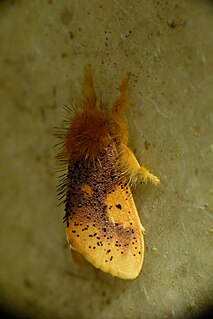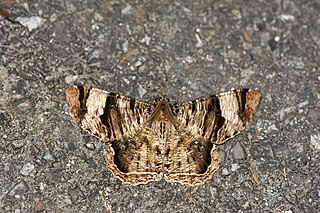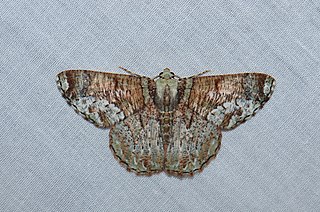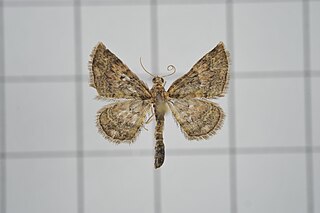Nishada is a genus of moths in the family Erebidae. They are found in India, Sri Lanka, Myanmar, Sumatra, and Borneo.
Pseudoscaptia is a monotypic moth genus in the family Erebidae erected by George Hampson in 1914. Its only species, Pseudoscaptia rothschildi, was first described by Max Wilhelm Karl Draudt in 1912. It is found in the north-eastern Himalayas, Vietnam, Thailand, as well as on Malacca, Sumatra, Java and Borneo. The habitat consists of lowland forests, including secondary forests.

Nygmia is a genus of tussock moths in the family Erebidae. The genus was erected by Jacob Hübner in 1820.

Comostola is a genus of moths in the family Geometridae erected by Edward Meyrick in 1888. They are found primarily in Asia and Australia.

Phyllodes eyndhovii is a noctuoid moth in the family Erebidae, subfamily Calpinae. The species was first described by Samuel Constantinus Snellen van Vollenhoven in 1858. It is found in the Himalayas, western China, Taiwan, Thailand, Sundaland and Palawan.

Avatha complens is a species of moth of the family Erebidae. It is found from the north-eastern Himalayas, the Andamans and Sundaland to the Solomon Islands. The habitat consists of dry, sandy heath forests and lower montane forests.
Asota paphos is a moth of the family Erebidae first described by Johan Christian Fabricius in 1787. It is found from the north-eastern Himalayas to Sundaland.

Xandrames latiferaria is a moth of the family Geometridae first described by Francis Walker in 1860. It is found in Japan, China, the north-eastern parts of the Himalayas and Sundaland.

Milionia basalis is a moth of the family Geometridae first described by Francis Walker in 1854. It is found in Japan, the north-eastern parts of the Himalayas, Myanmar and Sundaland.

Targalla subocellata is a moth in the family Euteliidae first described by Francis Walker in 1863. It is found in Taiwan, the north-eastern part of the Himalayas, Sundaland, the Philippines, Sulawesi, the southern Moluccas, New Guinea and Queensland.

Dindica polyphaenaria is a moth of the family Geometridae first described by Achille Guenée in 1857. It is found in Taiwan, the Himalayas, south-east Asia and Sundaland.
Somera virens is a moth of the family Notodontidae first described by Wolfgang Dierl in 1976. It is found in the north-eastern Himalayas, Sundaland and the Chinese provinces of Hainan and Yunnan.

Lophophelma erionoma is a moth of the family Geometridae first described by Charles Swinhoe in 1893. It is found in the Chinese provinces of Hunan, Guangxi, Zhejiang, Fujian, Jiangxi, Hainan and Sichuan, and in the north-eastern Himalayas and Sundaland. The habitat consists of lower montane and upper montane forests.
Lophophelma funebrosa is a moth of the family Geometridae first described by William Warren in 1896. It is found in the north-eastern Himalayas and Sundaland and on Sumbawa. The habitat consists of lowerland forests.
Pingasa venusta is a moth of the family Geometridae first described by William Warren in 1894. It is found in the north-eastern Himalayas, Sundaland and on Sulawesi, Seram and on New Guinea. The habitat consists of lowland areas up to 1,930 meters, including disturbed vegetation and secondary forests.

Gymnoscelis albicaudata is a moth in the family Geometridae. It is found in the north-eastern Himalayas and on Peninsular Malaysia, Java, Bali, Borneo, the Philippines, Taiwan and Japan. The habitat consists of upper montane forests.
Asura calamaria is a moth of the family Erebidae first described by Frederic Moore in 1888. It is found in from the north-eastern Himalayas to Sundaland, including Myanmar. The habitat consists of disturbed forests, including disturbed alluvial forests and remnants of primary montane forests.
Nishada rotundipennis is a moth of the family Erebidae first described by Francis Walker in 1862. It is found on Borneo and Peninsular Malaysia and in Myanmar and the north-eastern Himalayas. The habitat consists of forests.
Nishada sambara is a moth of the family Erebidae first described by Frederic Moore in 1859. It is found on Sumatra, Borneo, Java, the Sangihe Islands, Bali and the Philippines. The habitat consists of lowland forests.

Hypochrosis pyrrhophaeata is a geometer moth in the subfamily Ennominae first described by Francis Walker in 1863. It is found in the north eastern Himalayas and Sundaland. The species is common, often abundant, in lowlands and hill forests up to 2000 m.









